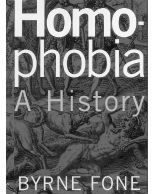THE GREEK WAY wasn’t always the gay-friendly way. In Homophobia: A History, Byrne Fone notes that homophobia—defined as “antipathy to [homosexuals] . . . and condemnation, loathing, fear, and proscription of homosexual behavior”—dates back to ancient Greece. Despite celebrations of homosexual relations in their letters and art, Greeks found homosexuality that wasn’t “manly, active, and controlled” problematic. The effeminate Greek was the flawed Greek.
Homophobia: A History
by Byrne Fone (Metropolitan Books, $32.50)
So marks the beginning of Fone’s exhaustively researched—and gay male- rather than lesbian-centered—chronicling of homophobia in Western civilization from antiquity to the present. Although numerous societies have risen and fallen since such Greeks as Euripides, Aristophanes, and Plato helped plant the seeds of homophobia, intolerance still flourishes in the West. Fone argues that “in modern Western society, where racism is disapproved, anti-Semitism is condemned, and misogyny has lost its legitimacy, homophobia remains, perhaps the last acceptable prejudice.”
While the Greeks and the Romans had their quibbles with sissies, cross-dressers, and male prostitutes, Fone’s work shows how it took the rise of ascetically minded Christianity and the problematic biblical story of Sodom to eventually transform occasional disapproval of homosexuality into institutionalized persecution. The Sodom story is problematic, Fone explains, because “if the . . . story advocates the punishment of homosexual acts, it does so even though no such acts are committed.” A large part of Fone’s book follows how the interpretation of this Genesis text mutated over the centuries at the cost of homosexuals’ lives: Unlike early readings, which claimed the Sodomites’ wickedness to be their “disregard for the ancient laws of hospitality,” later interpretations linked their sin with homosexuality. Thus, a biblical passage written when homosexual identity didn’t even exist (a German-Hungarian journalist coined the term “homosexual” in 1868) has helped transform the modern gay into the whipping boy of the religious right. As Fone quotes John McNeill, “in the name of a mistaken understanding of the crime of Sodom and Gomorrah, the true crime of Sodom and Gomorrah has been and continues to be repeated [by the Christian West] every day.”
Homophobia never receives a detailed analysis in Fone’s book. At times suggested as a social dysfunction, at others a fact of human existence, the phobia’s origins—along with its implied link to misogyny—remain a mystery. Instead, Homophobia: A History offers passages from diverse literature—from sodomy trials in Elizabethan England to Walt Whitman’s poetry to Newsweek articles—to explore the impact of homophobia on its victims. More disturbing than cathartic, Fone’s book reenacts the parade of atrocities that has been allowed to march on through the years largely unmolested. Homophobia stains historical figures like Augustine, Thomas Aquinas, Montesquieu, and Thomas Jefferson, who “recommended castration as the penalty for sodomy between males.” As Fone combs through the eras, homosexuals accumulate a slew of unappealing adjectives: impure, unnatural, heretic, diseased, subversive, un-American. Saddest of all, readers realize to what degree Western society has punished same-sex love and desire. In Amsterdam during the Enlightenment, “sodomites were killed by garroting, after which their faces were scorched. Some were drowned, held under water in a barrel placed upon a platform, as the populace watched their struggles. To make sure that their bodies no longer polluted the nation, they were then burned to ashes or weighted down and thrown into the sea.”
BEYOND THE GAY rights movement— a 30-year-old, divisive fraction of a minority trying to right over 2,000 years of wrongs—America and its views on homosexuality have more in common with medieval times than one might imagine. Fone states that in 1998, “54 percent of Americans still believed homosexuality to be a sin, and even more—59 percent—believed it to be morally wrong.” Unlike their heterosexual counterparts, homosexuals are still “second-class citizens” who can’t legally marry or join the military, and in most states receive no protection from hate crimes or termination from their jobs without due reason. In his introduction Fone suggests, “Like so many of the seemingly immutable forces of history, [homophobia] may be open to change, even to eradication. This book is intended as a contribution to that enterprise.” An important work, Homophobia: A History successfully records a portion of the often elusive past of a largely invisible and highly vilified minority. But as this book makes clear, when it comes to unburdening the West from its homophobic shackles, people must do more than read.








